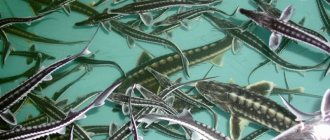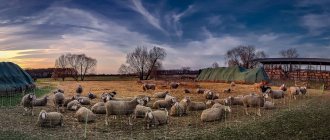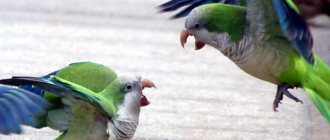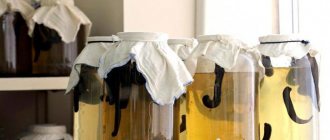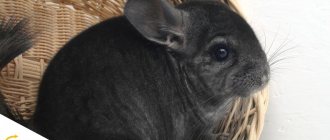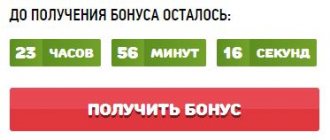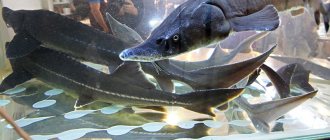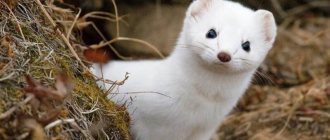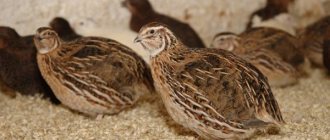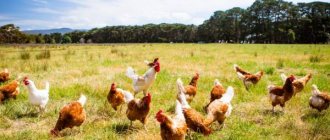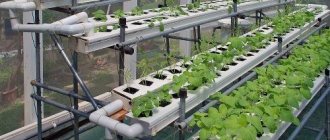Clothing made from natural fur has always been popular: it was believed that it shows others the high status and wealth of the owner. Therefore, after the depletion of natural resources, enterprising people began to think about the prospects of breeding fur-bearing animals in artificial conditions. However, practice has shown that not all animals take root well in captivity.
In this regard, breeding nutria at home differs significantly from other areas of fur farming. These rodents feel great in cages, happily eat common plant foods, quickly gain weight and actively reproduce even in small farms. If we take into account that nutria have enviable health and require minimal care, then we can say that their cultivation will be a suitable business for beginning farmers.
Business Features
Breeding nutria at home as a business is an activity aimed primarily at the production of two main types of products:
- Skins. Used for sewing outerwear, collars and hats. The farmer can sell them raw or processed;
- Meat. It has a delicate taste, and therefore is quite expensive. It is believed to improve the functioning of the digestive system and reduce cholesterol levels.
Of course, less exotic branches of livestock farming are also available to a novice entrepreneur. But the small spread of nutria cultivation among farmers is at the same time an advantage: there is practically no competition in this area. This line of activity has other advantages:
- Caring for animals is easy. This does not require complex devices and expensive automated systems;
- Growing nutria, unlike breeding and keeping decorative rabbits, does not require constant care for the health of pets;
- Animals grow very quickly. By the age of six months, nutria gain a marketable weight of 4–5 kg, after which they can be slaughtered;
- To feed nutria, ordinary products are used that any farmer or owner of a country house can grow on his own plot;
- Organizing the cultivation of nutria is one of the simple ways to receive a grant for farming development.
However, a novice farmer will have to face not only the advantages, but also the disadvantages of the nutria breeding business. Some of them can turn into problems for inexperienced beginners:
- Rodents must be kept clean. If cages are not cleaned daily, animal fur may lose its marketable appearance;
- Growing nutria as a business is not widespread in Russia. Therefore, difficulties may arise when marketing products;
- The male nutria is a fairly large and strong animal. Not everyone can score it carefully without ruining the skin.
Nutria breeds for breeding
Nutria is a waterfowl rodent that simultaneously resembles a large rat and a beaver.
The average length of an adult animal, not counting the tail, is 55–60 cm, and its weight is about 6–7 kg. In its natural environment, nutria lives mainly in South America, but with the help of humans it has been successfully acclimatized in Europe. Breeders divide nutria breeds suitable for breeding into three groups - standard, dominant and recessive. The standard ones are more reminiscent of their wild ancestors: they have a brown coat color, weigh up to 5–7 kg and are highly fertile. Their skins are not highly valued - around 500 rubles apiece.
Dominant breeds, when crossed with standard-colored nutrias, produce at least half of the puppies with a unique coat color. This:
- Azerbaijani white. It is distinguished by the same white color of hair and undercoat. Weight is 5–7 kg. During intrabreed mating, females bring 4 puppies, two or three of which are white. When crossed with a standard breed - half;
- Black. It has thick black fur and a dark gray undercoat. Weight is 5–7 kg. Intrabreed mating produces black puppies. When crossed with a standard breed - equal parts black and standard color;
- Golden. You can get a noble shade of fur with proper nutrition. Weight reaches 6–8 kg. Intrabreed mating produces only golden puppies. Crossing with a standard breed - equal parts golden and standard color.
Recessive breeds, when crossed with standard ones, produce offspring either of the usual color or with a coat shade different from the parent.
These include:
- Italian white. Unlike the Azerbaijani, it has a cream undercoat. Brings up to 5 puppies. Intrabreed mating results in white nutria. When crossed with a standard breed - silver;
- Beige. Distinguished by beige hair and brown undercoat. To get beige offspring, you need intrabreed mating. Crossing with a standard breed gives an unpredictable result - gray, standard, beige puppies;
- Lemon. It is a light variation of the golden nutria. It is obtained by crossing Italian females with golden males. When mating within the breed, the offspring will be white, golden, lemon or silver;
- Silver. It has a gray color with variations from dark to light. Grows up to 8 kg. They obtain a noble silver shade by intra-breed mating or crossing Italian nutrias with standard and beige ones;
- Snezhnaya. Grows up to 10 kg and gives birth to 4–5 puppies. It is obtained by mating silver females with golden males. To increase the productivity of the female, the snow nutria is crossed with the white Italian;
- Mother of pearl. It has matte silver fur with zonal coloring and a blue undercoat. You can get pearlescent nutria by crossing beige individuals with white Italian ones. Intrabreed mating gives an unpredictable outcome;
- Pastel. The brown pastel shade is the result of crossing black nutria with pearlescent or golden ones. Such a rare color in animals appears only after the second or third moult;
- Pearl. It has ash-colored hair and a creamy-silver undercoat. The breed was obtained by crossing the snow breed with lemon and pastel breeds. Mating with pastel males produces 50% pearl offspring.
Animal selection criteria
Nutria is selected according to the following parameters:
- direction of productivity;
- fertility;
- age;
- price.
First of all, the desired direction of the economy is determined - meat or fur. Most breeds of swamp beavers are versatile. The sale of puppies becomes a separate source of income. To obtain a large volume of production, you should choose fertile breeds of nutria: standard, white Italian, golden or pearlescent. To obtain meat, it is recommended to buy any one breed of animal.
The favorable age for purchasing puppies is 3 months. The cubs have already weaned themselves from mother's milk, are independent and ready to fatten. It is better to buy nutria from specialized farms and nurseries. There, the animals constantly undergo veterinary control, and the owners monitor the purity of the breed.
See also
How to properly cut nutria and how long it grows before slaughter, equipmentRead
Methods for growing nutria
The method of setting up a farm for growing nutria depends on the climatic characteristics of the region, the entrepreneur’s availability of free premises and his own food supply. There are four schemes for keeping rodents:
- In a cage without a pool. Used to keep families of one male and 4–5 females. The cage consists of a small house and a walking area fenced with a net. The stocking density is 0.3–0.4 m² per animal;
- In a cage with a pool. The design of the cage is similar to the previous one, but on the walking area there is a small pool of 15–20 liters, made of metal or plastic. The water in the container is changed daily;
- In the enclosure. The enclosure is an area of 5–8 m² filled with concrete and fenced with a net. Inside there is a swimming pool, a walking area and several houses. Breeding nutria in enclosures is practiced in the southern regions;
- In the hole. In mild climates, animals can be kept in pits up to two meters deep. The walls and floor of the pit are covered with concrete or slate. The internal space is divided into compartments with houses. It is very difficult to arrange a swimming pool.
Possible risks
Naturally, against the background of an extensive list of advantages, several risks of the nutria breeding business stand out. For example, it will be quite difficult for a novice breeder to find a buyer of fur and meat. This will require time and certain costs to advertise your products.
Also, if you do not have your own feed supply, you need to take care of reliable feed suppliers in advance. In addition, a certain reserve of food for animals is necessary.
It is not recommended to breed such animals in urban environments or near large industrial enterprises. The noise causes the animals to lose their appetite. They become aggressive, irritable, and miscarriages occur. Therefore, this moment also acts as a risk, and if possible it is better to avoid it by moving the nutria farm to a quieter area.
How to buy nutria?
Nutria are not rabbits. They cannot be purchased at the nearby farmers market. Therefore, an entrepreneur will have to be puzzled by finding specialized farms or nurseries that sell breeding animals. Such enterprises often publish offers on message boards and farm marketplaces on the Internet. It is likely that a beginner will have to go to another region for rodents.
Having decided where to buy nutria for breeding, you need to figure out how to choose the right animals. There are several recommendations:
- To raise nutria for meat, it is necessary to purchase young animals older than two months, accustomed to combined feed;
- To produce high-quality fur, it is better to buy healthy and productive adult animals, and also study the rules of crossing them with each other;
- When selecting animals, you should examine the incisors. In healthy nutria they have a uniform orange color, in sick ones they have blackened areas and pigmentation;
- Other signs of good health are a shiny coat, dense guard hairs and undercoat, and no cracks in the skin of the hind legs;
- Beginners should learn the breeding and care, as well as the reproduction of nutria on standard breeds: these animals get sick less and eat any food.
If a farmer already has a certain number of animals, then new rodents cannot be immediately released into common cages. It is recommended to keep them in quarantine for one and a half to two weeks. During this time, newcomers will get comfortable in an unfamiliar environment, and the owner will make sure that there are no sick individuals among them.
Attachments
Like any other business, breeding nutria requires certain investments. But thanks to the low monthly costs and the total amount required to open, the initial expenses pay for themselves within six months.
In addition, at certain points you can save significantly. For example, purchase not new, but used cells. Or even make houses for nutria with your own hands according to one of the drawings that can be found on the Internet.
But a novice breeder will still have to make certain investments in purchasing animals, preparing feed and some other issues.
Purchasing animals
The average cost of a pair of ordinary nutria in Russia starts from 2500–3000 thousand rubles. They look the same as their wild relatives. But in addition to the standard variety, there are also colored individuals with white, smoky, golden and other colors. A pair of such animals costs 2–3 times more.
It is worth buying animals that have already reached the age of 2-3 months. Moreover, during the purchase, be sure to check the condition of the rodent’s fur and incisors. The purchase is carried out in the spring and summer so that the animals gain weight before the cold weather.
Choosing nutria to buy
Immediately after the purchase of livestock and the first successes in breeding it, a certain part of the money should be invested in advertising. It will help you find buyers for fur and meat. Information about their business and the products they sell are often posted on bulletin boards on the Internet. It would also be a good idea to publish a note about this in the newspaper. Naturally, each of these options involves a certain fee.
Often customers themselves post advertisements for the purchase of such products. Meat is purchased by restaurants, and fur by companies specializing in clothing.
Settlement costs
The bulk of the budget is spent on arranging houses for animals. They can be purchased ready-made or made yourself. In any case, such a product must meet the following standards:
- walls made of metal mesh or lattice;
- insulation for the winter if the cage is located in an unheated room;
- the presence of a closed corner or house in which the animal will hide;
- presence of a swimming pool;
- a separate corner for the dining room with fixed feeders and drinkers.
When arranging a common walking area, its floor should be concreted. Also suitable is the option of laying a metal grate, on which crushed stone is poured on top. Living creatures quickly gnaw or tear apart a wooden or earthen floor.
It should be noted that in addition to cages for individual housing of rodents, it is also necessary to purchase a larger house for adult individuals for the mating period. Certain investments will have to be made when purchasing a cell used as a queen cell.
Feeding
The ideal way to save on purchasing food supplies is to locate a nutria farm on the bank of a natural body of water (a pond or a slow-flowing river). Then the animals will find food for themselves. The basis of their diet in this case will be the succulent stems and leaves of reeds, water lilies, reeds, and arrowheads. The animal happily eats leeches and small fish.
Your own vegetable garden or garden also provides certain savings. In general, the animal eats about 2 kg of food per day. In this case, the basis of the diet for home breeding is the following components:
- green grass, for example: clover, peas and alfalfa (daily value up to 350 g);
- grains, including barley, corn, rye (at least 120 g per day);
- cake;
- mineral supplements in the form of fishmeal and a small amount of table salt.
The winter diet is almost the same. The only difference is that instead of grass, the rodents are fed hay.
You can also diversify the menu:
Vegetables and root vegetables
- vegetables and root vegetables: zucchini, beets, carrots, cabbage, potatoes (given without fail);
- reed;
- weeds from the garden or garden;
- fresh seaweed;
- young shoots of willow, birch and oak;
- apples.
Important! The branches are given either cut or whole. Vegetables are pre-washed and chopped. Grass and hay are filled with water. All menu components are mixed into a homogeneous mass before serving. Otherwise, the animal will prefer concentrates.
How to care for nutria?
Breeding and keeping nutria at home does not require any special procedures. It is enough to follow basic hygiene rules, keep the cages clean and provide the animals with adequate nutrition:
- When feeding with mixed feed, the drinking bowls must be constantly filled with water. This is especially important when keeping nutria in cages without pools;
- Enclosures and cages must be regularly cleaned of hair, droppings and food debris scattered by rodents;
- It is recommended to remove down nests made by females only when they become dirty or if parasites are found in them;
- You cannot leave yesterday's food in the feeders. Wet mash, fresh and boiled vegetables disappear very quickly;
- Cages intended for the removal of pregnant females or young animals must be pre-treated with disinfectant compounds.
Despite their thick fur, nutria are heat-loving rodents. The paws and tails of animals unprotected by fur are the first to suffer from frost. Therefore, when winter comes, you need to protect your pets from hypothermia:
- When the outdoor air temperature drops to 12–14°C, animals must be kept in a warm room;
- Cages should be filled daily with dry bedding made from straw or sawdust. If the material becomes wet, replace it immediately;
- You should not use water to clean cages and enclosures in winter. To maintain cleanliness, you should clean more often than in summer;
- Nutria should not be given greens, vegetables, fruits and other succulent foods that have been frozen.
On small farms, keeping rodents without water is allowed. Growing and caring for nutria is simplified, and cages without pools are easier to build. However, many experts argue that in animals deprived of the opportunity to bathe, the hair combing reflex disappears, the quality of the fur deteriorates, the skin on the paws cracks and excess weight appears. Accordingly, pets still need a small pool.
But at the same time, the nutria immediately turn the pond into a toilet and begin to drag food here: swimming in such a container is unlikely to improve the quality of the skin. Therefore, the pool must be cleaned daily. If this is technically difficult, you can water your pets with warm water from a garden hose.
What to feed nutria?
In the natural environment, the diet of nutria consists of aquatic plants, small mollusks, young shoots of trees and succulent grasses. At home, you cannot feed them grain alone: for proper nutrition, rodents need greens and root vegetables. At the same time, the farmer may encounter a problem: the animal eats up to one and a half kilograms of food per day, and therefore, without its own food supply, breeding nutria as a business becomes unprofitable. Accordingly, it is advisable to raise rodents in rural areas where there are meadows, forests and vegetable gardens. In summer, the diet of nutria may include:
- Green mass - quinoa, dandelions, meadow grasses;
- Beet and carrot tops, corn shoots;
- Reeds, reeds and other aquatic vegetation;
- Fresh fruits and vegetables - carrots, cabbage, beets, pumpkin, apples;
- Crushed grain of wheat, barley, corn, oats soaked in water;
- Ready-made feed for laying hens, calves and piglets.
Recommended feeding rates for adult breeding nutria during the warm period reach 1000–1200 g per head per day:
Nutria feeding rate in summer
| Feed | For adults | Young animals 0–2 months. | Young animals 2–6 months. |
| Green mass, g | 800–1100 | 180–400 | 400–800 |
| Grain feed, g | 100–160 | 35–40 | 80–100 |
| Table salt, g | 0,5–1,0 | 0,2–0,5 | 0,5–1,0 |
| Chalk, g | 1–2 | 0,2–0,5 | 0,5–1,0 |
| Powdered milk, g | 15–25 | 10–20 | 10–20 |
| Meat and bone meal, g | 8–12 | 5–8 | 6–10 |
In winter, the green mass in the animal diet is replaced with pre-prepared meadow grass hay, straw, quinoa, and grass meal. In addition to this, nutria are given wet mash, which contains:
- Carrots, pumpkin, beets and other vegetables;
- Boiled potatoes;
- Steamed crushed grain of wheat, barley, corn, oats;
- Ready-made feed for laying hens, calves and piglets.
Approximate feeding rates for adult breeding nutria during the cold season are presented in the following table:
Feeding norm for nutria in winter
| Feed | For adults | Young animals 0–2 months. | Young animals 2–6 months. |
| Root vegetables, g | 400–600 | 120–150 | 250–300 |
| Grain feed, g | 100–160 | 35–40 | 85–110 |
| Hay, g | 100–120 | 40–50 | 90–110 |
| Table salt, g | 1–2 | 0,5–1,0 | 0,5–1,5 |
| Chalk, g | 1–2 | 0,5–1,0 | 0,5–1,5 |
| Fish oil, g | 0,5 | 0,3–0,5 | 0,5–1,0 |
To increase immunity, it is recommended to introduce mineral and vitamin supplements into the nutria diet, mixing them with food. Pushnovit preparations and premixes contain vitamins A, B6, B12, D, E, necessary for rodents, as well as microelements - iron, potassium, copper, iodine, zinc.
How to breed nutria?
Puberty in nutria occurs in the fifth month of life, but for mating it is better to select animals weighing at least 4 kg. Depending on the goals pursued by the farmer, various methods of breeding nutria at home are practiced for beginners:
- Manual. The male is kept in a separate cage. The female is placed next to him for a week immediately after giving birth. The procedure is repeated every 24–25 days until results are achieved. Due to its high labor intensity, the method is only suitable for small farms;
- Kosyachny. A group of 8–12 young females is collected. Upon reaching maturity at 7–8 months, a male is placed with them. At the first signs of pregnancy, animals are moved to separate cages;
- Free. A group of females is placed in a cage with several males. When almost all of them are fertilized, the remaining ones are moved to another pen. New animals are added to them to form the next group;
- Family. A pen with several houses contains a male and 3–5 females. In this case, pregnant nutria are not removed. Therefore, to prevent conflicts, individuals who were previously kept together are selected into the family.
The average fertility of nutria is 5.5 individuals, although cases of 15–18 puppies being born are known. Babies weighing 320–350 g are born 128–135 days after mating. They already have teeth and open eyes, and therefore after a couple of days they confidently run and swim. Although nutria feed them milk for up to 50 days, puppies can eat adult food on their own by two weeks of age.
How to keep young animals?
At two months, the young are separated from the mother, placing the latter back in the cage with the family. The litter is kept together for some time, and at the first manifestations of sexual activity at the age of four months, they are distributed among cages according to sex. Pup stocking density is 0.12–0.14 m² per female and 0.16–0.18 m² per male.
Groups are made up of individuals of the same sex with approximately the same age and weight. The young animals are observed for several days in order to identify and isolate the most violent and aggressive individuals. When young nutria get used to each other, you cannot add new puppies to them: this can also provoke fights.
By about eight months, the growth rate of young animals slows down significantly, which makes their further maintenance and feeding irrational. At this age, puppies weigh about 5–6 kg and are up to 60 centimeters long:
Average weight of nutria, kg
| Age, months | Females | Males | ||
| Weight, kg | Length, cm | Weight, kg | Length, cm | |
| 0,5 | 0,5 | 25 | 0,6 | 26 |
| 1 | 0,7 | 27 | 0,8 | 28 |
| 1,5 | 1,1 | 30 | 1,2 | 31 |
| 2 | 1,4 | 34 | 1,7 | 35 |
| 3 | 2,0 | 40 | 2,3 | 41 |
| 4 | 2,5 | 44 | 3,1 | 46 |
| 5 | 3,3 | 47 | 4,0 | 50 |
| 6 | 4,0 | 49 | 4,7 | 53 |
| 7 | 4,5 | 51 | 5,5 | 56 |
| 8 | 5,0 | 54 | 6,0 | 58 |
| 9 | 5,2 | 55 | 6,3 | 60 |
Why register a business?
Strictly speaking, official status is not needed to breed nutria: the owner of a private household plot can sell meat at the market and hand over the skins to procurement offices. But all startups 2021 in Russia need to be registered sooner or later. In this case, cooperation with other entrepreneurs or legal entities is greatly simplified if you have documents of an individual entrepreneur or peasant farm. The following OKVED codes are suitable for keeping nutria:
OKVED codes for growing nutria
| 01.49 | Breeding other animals |
| 01.49.2 | Breeding rabbits and other fur-bearing animals on farms |
| 01.49.22 | Breeding other fur-bearing animals on farms |
According to the law, nutria breeding in Russia is classified as an agricultural activity (OKPD product code 01.49.19.240). Therefore, the farmer has the right to use the preferential taxation system of the Unified Agricultural Tax with payment of 6% of the profit to the state.
In order to freely sell meat to stores and catering establishments, the entrepreneur must prove that the conditions for keeping nutria meet established standards. To do this, you need to undergo verification and receive some documents:
- Conclusion of Rospotrebnadzor on compliance with sanitary rules;
- Conclusion of the State Fire Inspectorate on compliance with safety regulations;
- Certificate of quality for nutria meat;
- Veterinary passport for each animal;
- Agreement with a veterinary institution for the discharge of VSD.
Advertising and sales
You can sell nutria meat or fur through different channels:
- A regular market in the city.
- Special procurement organizations.
- Fur factories.
- Through the Internet.
- Live animals are also sold to other farmers for breeding.
Almost no advertising is required. Typically, such information is spread by word of mouth, and personal meetings are also organized with the owners of procurement companies or fur factories. When exporting nutria meat to the market, it is enough to make a sign with information about the benefits of such a product.
How to prepare the room?
In the Russian climate, it is impossible to provide care and breeding for nutrias in comfortable conditions without a closed room. Therefore, to equip the farm, you will have to use an existing building or build a new one from brick, wood, aerated concrete or sandwich panels:
- In warm southern regions, cages are arranged so that the houses are located indoors, and walking areas with swimming pools are located outside. In winter, the openings to the outside are closed with flaps, and the animals are fed in the houses;
- In temperate and cold climates, the cages are installed inside a heated farm. When kept without pools, they can be arranged in several tiers. In summer, cages with animals are taken outside.
Considering the breeding of nutria at home in detail, it is necessary to pay attention to a number of requirements that apply to the premises of the farm:
- All cracks and openings must be closed to prevent animals from catching cold from drafts. The room should be dry and warm;
- In winter, a comfortable temperature for nutria is 14–16°C, in summer - no more than 26°C. Recommended air humidity is within 70–80%;
- The optimal way of lighting is a combination of windows and lamps. The illumination level should be 100–250 lux;
- When growing nutria at home, the daylight hours need to be extended only in winter, turning on the lamps for one and a half to two hours in the morning and evening;
- Fresh air must be supplied to the room in a volume of 2–3 m²/h in winter and 4–5 m³/h in summer. In the cold season it should be heated;
- Near the farm there should be no sources of sharp and loud sounds - railways, highways, industrial enterprises;
- You need to dig a hole on the site and install a sewer system to drain and settle dirty water from the pools.
Choosing a site for building a farm
Nutria (photo below) spend a lot of time in water and feed mainly on plant foods.
Photo of nutria
The site for the nutria farm is chosen in relation to the requirements of this animal, namely:
- the area should have a mild climate;
- on the fur farm site there should be reservoirs with low-flowing water that freezes in winter for no more than 2-3 weeks;
- in the case of semi-free keeping of animals, nutria choose reservoirs overgrown with reeds, cattails, reeds, water chestnuts, sedges and other vegetation;
- near a nutria farm, it is necessary to have a sufficient plot of land to provide the animals with grain, root crops, grass and good-quality hay. It is advisable that there be a deciduous forest nearby, since nutria readily eat branches of oak, hazel, etc.
Pictured are domesticated nutrias being bred
Arranging a canal near the nutria cells
When building a nutria farm, a main distribution channel is drawn from the main water source, and ditches are dug and concreted perpendicular to this channel, along which cages for nutria are built. The ditches are made 2.5 meters wide at the top, 0.5 meters wide at the bottom, and the depth of the ditch is 0.7-0.8 meters. The length of each ditch depends on how many cells will be placed on its sides.
Photo of nutria at a watering hole
Nutria cage
Cages intended for housing nutria are built of concrete measuring 2.5 X 1.5 X 0.8 meters. The fourth wall of the cage is made of a metal mesh, which is embedded in the concrete side walls and lowered into the water so that it encloses part of the ditch for swimming and bathing of animals. The top of the mesh wall is bent with a canopy 30 centimeters into the cage, which protects the nutria from escaping. The concrete floor of the nutria cage slopes towards the water at an angle of 30 degrees. The floor serves as a walking area.
Drawing of a cage for keeping nutria
Photo of a cage for nutria
The cells are built on both sides of the ditch with a gap of half a meter between the opposing nutria cells. The house is also built from concrete, and its lid is made of wood and covered on the inside with metal mesh. The dimensions of the house are 0.6 X 1.0 meters, the height at the wall of the cage is 0.6 meters, and the height of the opposite wall of the house is 0.4 meters; a hole measuring 20 X 20 centimeters is built from the house into the cage.
Cages for young nutria
In areas where there are frosts in winter, the interior walls of the house are also made of wood. To raise young nutria, cages are built of the same design as for adult nutria, but larger in size (3.0 X 2.5 X 0.8 meters), and the houses are made 2-3 times longer. 10-15 puppies are raised in such a cage.
Arrangement of pens for nutria young animals
More often, pens are set up for raising young nutria, which require significantly less costs.
A paddock is an area enclosed by a mesh fence on the shore of a reservoir with running water. Pens come in sizes of 30 X 10 meters and larger. Part of the reservoir, included in the pen and fenced with a net, serves as a swimming pool for the young animals.
A mesh fence is made from 0.8 to 1 meter high by nailing the mesh to the posts. To prevent animals from escaping, the net is dug into the ground to a depth of 40 centimeters, and a canopy 30 centimeters wide is made at the top of the net. In such a pen they contain from 50 to 80 heads of young nutria, for feeding which a concrete platform measuring 4 X 2 meters is arranged.
A canopy is arranged in the pen so that the animals can take shelter under it in inclement weather. To serve the animals, there is a door in the fence of the pen.
Semi-free breeding of nutria
To keep the animals semi-free, the farm fences off several tens of hectares of a shallow reservoir, densely overgrown with swamp vegetation, with a mesh fence, and releases the nutria there. In a fenced area, they organize feeding of nutria in certain places, where in the fall they install feeders - traps for catching, culling and slaughtering animals.
In the photo there is a nutria in a pond
Semi-free breeding of nutria in the middle zone requires the construction of special insulated rooms for keeping animals in the winter.
Keeping nutria without ponds
Fur farms successfully use a system for keeping nutria in cages without ponds. This made it possible to begin mass breeding of nutria not only in the southern, but also in the central regions of the country.
The main buildings of such a nutria farm are a wintering barn and portable houses for nutrias with mesh paddocks.
With the onset of the first frosts, the houses are installed in wintering sheds along the walls and carefully insulated on the outside by installing wooden panels along the central passage and filling the space between the panels and houses with dry, non-heat-conducting material (sawdust, peat, cut straw, etc.).
Mesh paddocks are installed on the outside of the barn, and nutria can leave the house in them through a pipe running in the wall of the barn.
Photo of adult nutria on the run
The floor of the mesh paddocks is raised above the ground by 35-40 centimeters. In areas with severe frosts, mesh paddocks along with houses for nutria are placed inside the wintering shed.
Drinking baths are placed in the mesh paddock, and in winter they are filled with clean snow.
With the onset of warm weather, houses and mesh paddocks are removed from the wintering shed and placed near a reservoir. The houses are placed on the shore, and the mesh paddocks are lowered at an angle into the water.
If the coastline is not convenient for installing houses, you can build special wooden walkways and place houses on them.
The mesh walk to the house for adult nutria has a trapezoidal shape and the following dimensions: 150 X 75 centimeters at the bottom and 150 X 40 centimeters at the top, the height of the walk is 50 centimeters, in the ceiling there is a door 60 X 40 centimeters. The frame is made of an iron rod with a cross-section of 12-14 millimeters, a galvanized mesh with a mesh clearance of 25 X 25 millimeters, a wire thickness of at least 2.5 millimeters.
Photo of nutria in an enclosure
Nutria houses are made from dry boards 25 millimeters thick, tongue or groove. It has a pipe, feeding and nesting compartments.
The size of the house is 100 X 80 centimeters, the aft compartment is 50 X 80 centimeters, the floor is solid plank. In the nesting compartment measuring 50 X 80 centimeters, there is a mesh floor on a separate frame, the length of the pipe for connecting to the mesh run is 50 centimeters, the cross-section of the pipe is 20 X 20 centimeters. The height of the back wall of the nutria house is 63 centimeters, the front wall is 36. The cover of the house is removable.
A conventional type of wintering shed can be built from a variety of local materials. The barn should have enough light, dense wind-proof walls and doors, and a light waterproof roof. The width of the barn is 4 meters.
Equipment for breeding nutria
Unlike a business like breeding chinchillas at home, growing nutria requires free space. Each family of five adults or a group of 10 puppies is kept in a separate cage 80 cm wide and 120 cm long. This cage includes a house and a walking area (or a house, a walking area and a swimming pool):
- The house is made of boards and lined with metal mesh on the inside. The roof is fixed on hinges. House length - 60 cm, width - 80 cm, height - up to 50 cm;
- The walking area is assembled from wooden frames, also lined with steel mesh. Its length is 120 cm, width is 80 cm, height is 50 cm;
- The pool can be made from a ready-made galvanized or plastic container. It is necessary to embed a tap into its bottom to quickly drain the water;
- Feeders and drinking bowls are mounted on the walls of the walking area so that animals do not tip them over and scatter food.
To prepare feed, you need special equipment - a feed cutter, a tank for steaming grain, a grain crusher. The farmer will also need gardening tools - a cart, shovels, pitchforks, rakes, buckets, scoops, brooms. Thus, in a business plan for breeding nutria, you need to take into account the costs of purchasing the following equipment:
Equipping a farm for 10 families
| Name | price, rub. | Quantity, pcs. | Amount, rub. |
| Feed preparation | |||
| Grain crusher | 3100 | 1 | 3100 |
| Feed cutter | 3700 | 1 | 3700 |
| Garden cart | 2600 | 2 | 5200 |
| Feed steamer | 9000 | 1 | 9000 |
| Hand tool | – | – | 8000 |
| Farm | |||
| Materials for cells | 4000 | 40 | 160000 |
| Thermohygrometer | 1300 | 1 | 1300 |
| Lamp | 400 | 20 | 8000 |
| Fan 2000 m³/h | 3600 | 4 | 14400 |
| Wood stove 40 kW | 35000 | 1 | 35000 |
| Heat exchanger 5 kW | 9100 | 2 | 18200 |
| Circulation pump | 7500 | 2 | 15000 |
| Cables and pipelines | – | – | 15000 |
| Water sediment tank | 18000 | 1 | 18000 |
| Water pump | 2500 | 1 | 2500 |
| Slaughter and cutting shop | |||
| Workwear | 1200 | 2 | 2400 |
| Cutting table | 8000 | 2 | 16000 |
| Inventory | – | – | 12000 |
| Boiler | 8900 | 1 | 8900 |
| Materials for rules | 200 | 200 | 40000 |
| Meat tray | 350 | 10 | 3500 |
| Refrigerator compartment 2 m³ | 45000 | 1 | 45000 |
| Total: | 444200 | ||
How to organize sales?
It is better to slaughter animals at the age of 7–8 months, when their skins are of the best quality. One-year-old nutrias have worse fur. To avoid accidentally spoiling a valuable product, you need to follow several recommendations:
- Excess weight negatively affects nutria meat and fur. Therefore, the diet of fat animals will have to be adjusted two weeks before slaughter;
- Before slaughter, you need to drain the water from the pool and put fresh bedding so that the rodents have time to dry their skins;
- If an entrepreneur wants to save on the services of a slaughterer, he must master this skill perfectly and acquire good tools.
Of course, growing nutria is significantly inferior in popularity to breeding pigs or keeping chickens. Therefore, you need to organize distribution channels in advance, so that later you don’t hastily look for where to sell half a ton of exotic meat and a couple of hundred skins. How to find buyers:
- Nutria skins are of interest to ateliers, factories and private craftsmen producing fur products;
- Also, special procurement offices are engaged in buying skins from citizens, often opening collection points at agricultural markets;
- Nutria meat is purchased by catering establishments, specialized butcher shops, retail stores and retail chains;
- To sell meat, you can open your own kiosk at the city market. Of course, in this case the farmer will need a salesman;
- Citizens who want to start growing nutria at home from scratch will want to purchase young animals and breeding families;
- Finally, skins and meat can be sold on online marketplaces and through your own website.
Staff
At home, it is better to manage on your own and with the help of family members, especially at the initial stage. Even 2 people can handle a small mini-farm. If volumes grow and there are no problems with sales, it makes sense to expand and hire employees, including a veterinarian.
In any case, during the period of slaughtering animals, it is better to spend money on finding and hiring a specialist in skinning, as this will increase the profitability of the enterprise.
How much should you invest in a farm?
A beginner can buy one family and install two or three cages in his garage: in this case, the cost of organizing a farm will be minimal. However, on a more serious scale, breeding nutria at home as a business requires an investment of at least 600–700 thousand rubles:
Investments in the farm
| Article | Amount, rub. |
| Registration of a farm as an individual entrepreneur (peasant farm) | 800 |
| Opening an account | 2400 |
| Rebuilding and insulating the farm | 150000 |
| Equipment | 444200 |
| Nutria breeding stock, 10 families | 50000 |
| Total: | 647400 |
Next, you need to calculate the current costs associated with maintaining the operation of the farm. You will have to spend the most on purchasing feed:
- Each family will consist of one male and four females. Ten families will bring the farmer 200 puppies a year;
- Ready-made feed for piglets costs up to 20 rubles per kilogram, so it is more profitable for a farmer to independently prepare a mixture from crushed grain;
- With combined feeding, one adult animal needs 50 kg of grain mixture per year. The cost of preparing it will be 500 rubles;
- When feeding a puppy up to eight months of age, the consumption of the grain mixture reaches 25 kg per year. The cost of grain for feed is 250 rubles.
In addition to feed, the entrepreneur needs to buy firewood for heating and medicines for vaccination. You also need to pay for electricity and meat certification:
Farm expenses per year
| Article | Amount, rub. |
| Insurance premiums for individual entrepreneurs (peasant farms) | 36240 |
| Account servicing | 7200 |
| Grain for feed | 75000 |
| Electricity | 24000 |
| Firewood for heating, 8 m³ | 12000 |
| Consumables | 18000 |
| Veterinary drugs | 12000 |
| Meat certification | 8600 |
| Fare | 12000 |
| Total: | 205040 |
Profitability of nutria breeding
The main goal of drawing up a business plan for breeding nutria with calculations is to assess the economic efficiency of the project. When making calculations, it should be taken into account that, theoretically, a female can bring a new litter every four to six months. However, the farmer will not have enough space to accommodate so many rodents. Therefore, on a farm of 40 cells, it will be possible to carry out only one breeding cycle per year and raise 200–300 heads of young animals to marketable sizes. Further:
- At eight months, nutria weighs 5–6 kg. The meat yield for males is 55–60%, for females – 50–55%. Consequently, up to 3 kg of product can be obtained from one carcass;
- The wholesale price for nutria meat is 500 rubles per kilogram. A carcass weighing 3 kg can be sold for 1,500 rubles;
- The skin of a standard breed of nutria costs at least 500 rubles. For rarer golden or black specimens you can actually get up to 1000 rubles.
Now you can take into account the amount of overhead costs and calculate the annual profitability of nutria breeding:
Profitability of growing nutria
| Article | Meaning |
| Income from the sale of 200 carcasses, rub. | 300000 |
| Income from the sale of 200 skins, rub. | 200000 |
| Expenses for the year, rub. | 205400 |
| Profit before tax, rub. | 294600 |
| Unified agricultural tax 6%, rub. | 17600 |
| Net profit, rub. | 277000 |
| Profitability, % | 134,8 |
| Investments, rub. | 647400 |
| Payback period, months | 27,9 |
"Fly in the ointment" in business
Before you start breeding nutria from a business point of view, you should know about the important and inherent disadvantages in this matter:
- Nutria are rats, and therefore the degree of natural disgust can affect this, since their appearance is not nearly as pleasant as, for example, that of rabbits or chinchillas.
- Breeding nutria is a very labor-intensive process. Constant cleaning and preparing clean food for nutria will require great patience and time.
- Slaughter requires physical strength and engineering precision so as not to damage the skin or spoil the meat. It is better to carry nutria by the tail to avoid injury from their sharp teeth.
However, growing nutria is not only an interesting, but also a very profitable type of business. With all the factors stated above, your animals will be able to bring you large income all year round and every month.
Sources
- https://businessmonster.ru/otkryitie-biznesa/biznes-idei/razvedenie-nutriy-v-domashnih-usloviyah.html
- https://realybiz.ru/idei/biznes-ideya-razvedeniya-nutrij
- https://FermHelp.ru/razvedenie-nutrij-kak-organizovat-biznes-v-domashnix-usloviyax/
- https://finzz.ru/biznes-razvedenie-nutrij-ot-a-do-ya.html
- https://agro365.ru/nutrievaya-ferma.html
- https://selskoehozjajstvo.ru/nutriya-v-domashnix-usloviyax/
- https://fermabusines.ru/nutriya/kormlenye/chto-nuzhno-znat.html.
[collapse]

